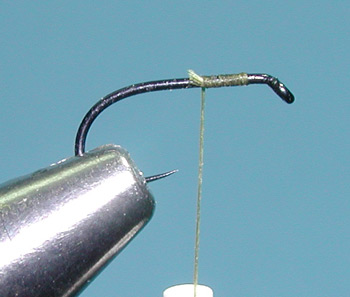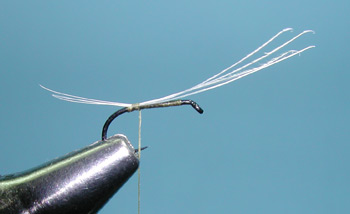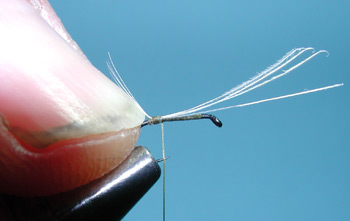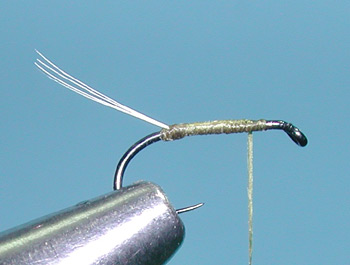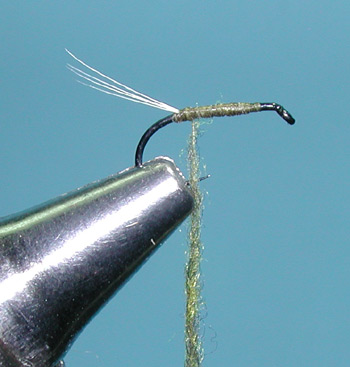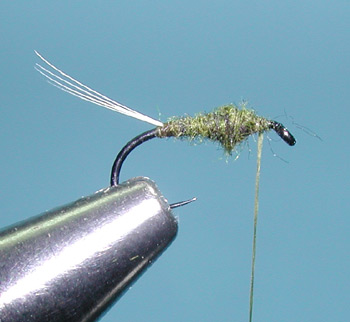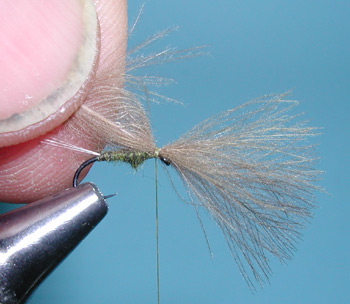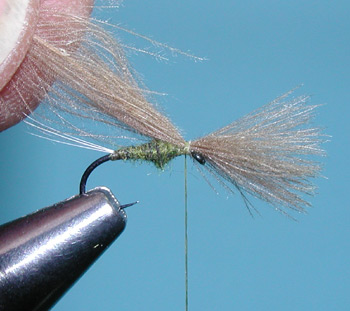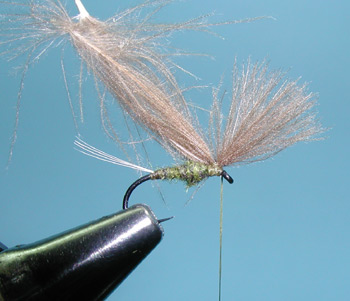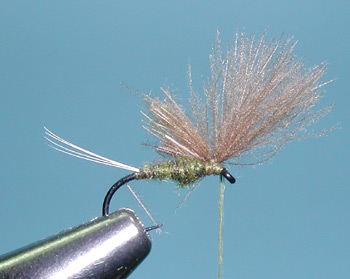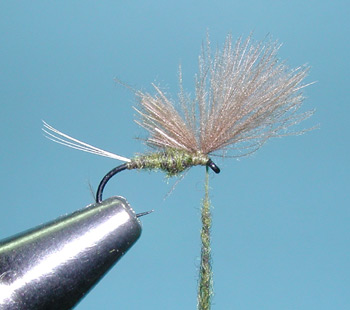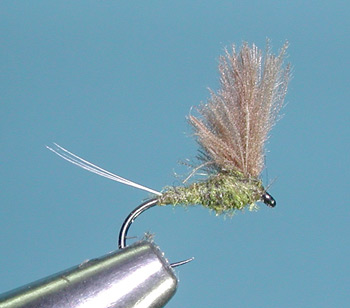CDC Dun – the proven promise of a preen
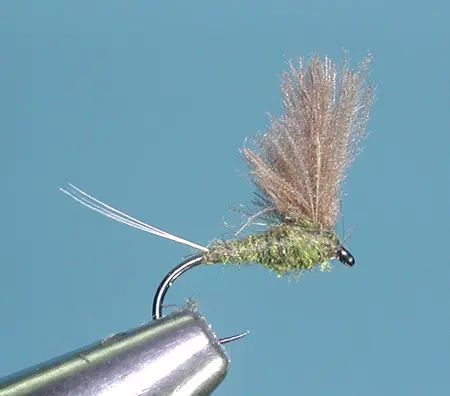
CDC Baetis Dun
Tying Instructions
| Materials
to Order Material, click the link |
|
|---|---|
| Hook | TMC 103bl #19-21 |
| Thread | Uni Thread 8/0 , Olive Dun |
| Body | Super Fine Dry Fly Dubbin, BWO |
| Tail | Light Dun Tailing Fibers |
| Wing | Med Dun CDC |
| Thorax | Super Fine Dry Fly Dubbin, BWO |
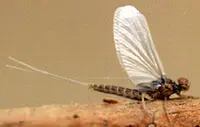
CDC Dun
The CDC Dun utilizes Cul-de-canard (CDC) feathers for the wing on this mayfly emerger pattern. The use of the feather has their roots going back to the 1920’s with the Moustique patterns used in the Jura Mountains of Switzerland. The feather is found near the preen glands of ducks. The preen gland produces an oil that coats the duck’s feathers. This coating of oil makes the duck’s feathers very water resistant and thus buoyant. The oil itself eventually spreads over the entire duck, but the CDC feathers are the most saturated because they’re nearest to the gland. It was first marketed in the United States in 1990 by Dennis Black of Umpqua Feather Merchants.
Shane Stalcup
 The late Shane Stalcup was one of the early tiers to utilize this material in the United States. He adapted the feather as a replacement for the Deer Hair wing on a Comparadun pattern in the late 1980’s. The feather can also be tied in a comparadun style without a hackle due to the high floatation character. Certainly, this is a progression of the No-Hackle pattern that was introduced by Swisher and Richards in the 1970’s.
The late Shane Stalcup was one of the early tiers to utilize this material in the United States. He adapted the feather as a replacement for the Deer Hair wing on a Comparadun pattern in the late 1980’s. The feather can also be tied in a comparadun style without a hackle due to the high floatation character. Certainly, this is a progression of the No-Hackle pattern that was introduced by Swisher and Richards in the 1970’s.
Parachute Dun style
In addition, CDC can be used as a wing post with a parachute hackle surrounding the post. Rene Harrop wrote about this feather in the July issue 1991 of Fly Fisherman magazine and showed his version of a CDC Parachute Dun. The use of this feather as a hackle will provide a somewhat higher profile and will withstand faster currents. Further, Marc Petitjean also popularized many techniques for utilizing the feather creating dun patterns with split wings.
Dun style
The CDC Dun can be tied in a number of sizes and colors to mimic a newly emerged mayfly. The style is particularly useful on small mayfly patterns such as PMDs or BWOs since the CDC wing provides very good floatation for a small hook size. The pattern remains simple with its tail of microfibetts or tailing fibers. The body can be tied with dubbing or quill, producing a slender, thin body. The wing is located above the thorax position and can be tied using a number of techniques. The simplest technique is to tie two plumes with the tips facing over the eye of the hook, pulling the plumes until the tips equal the length of the shank. Then, trim the back half of the feather with a taper. Another technique is to trim the fibers off two plumes and anchor these fibers to the thorax region, pulling the fibers for desired length. The two plume tips are secured in front of these fibers and secured upright for wings.
Variations
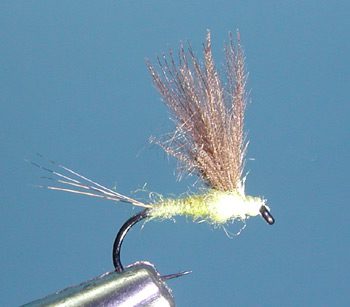
CDC PMD Dun
| Hook | TMC 103bl #15-19 |
| Thread | Uni-thread Light Cahill 8/0 |
| Body | Superfine, Golden Olive |
| Thorax | Superfine, PMD |
| Tail | Coq de Leon, Medio Pardo |
| Wing | Med. Dun CDC |
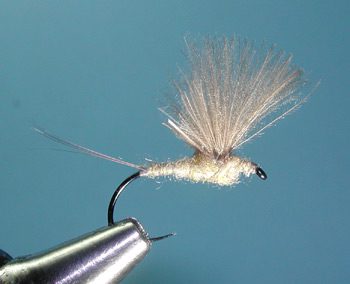
CDC Callibaetis Dun
| Hook | TMC 103bl, #13-15 |
| Thread | Uni-thread Gray 8/0 |
| Body | Superfine Callibaetis |
| Thorax | Superfine Callibaetis |
| Tail | Med Dun Tailing Fiber |
| Wing | Light Dun CDC |
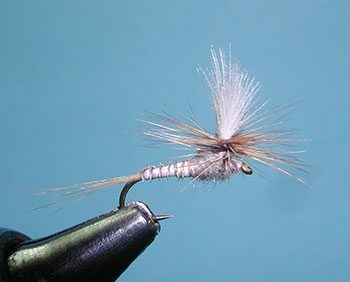
CDC Biot Parachute Dun
| Hook | TMC 100, #14- 18 |
| Thread | Uni-thread Gray 8/0 |
| Body | Gray Goose Biot |
| Thorax | Muskrat |
| Tail | CDL Med Pardo Tailing Fiber |
| Wingpost | White CDC |
| Hackle | Grizzly Dun Rooster Cape |
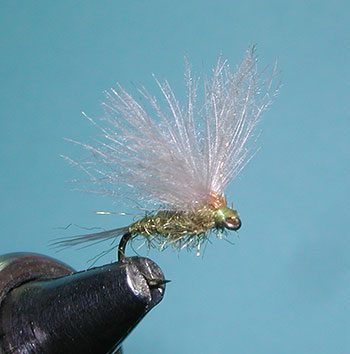
CDC Split Wing Dun
| Hook | TMC 100, #14-22 |
| Thread | Veevus 12/0 Light Olive |
| Body | BWO Nature's Spirit Emergence Dubbing |
| Thorax | BWO Nature's Spirit Emergence Dubbing |
| Tail | Medium Dun Tailing Fiber |
| Wing | Natural Dun CDC |
| Wingcase | Light Brown Antron Yarn |

